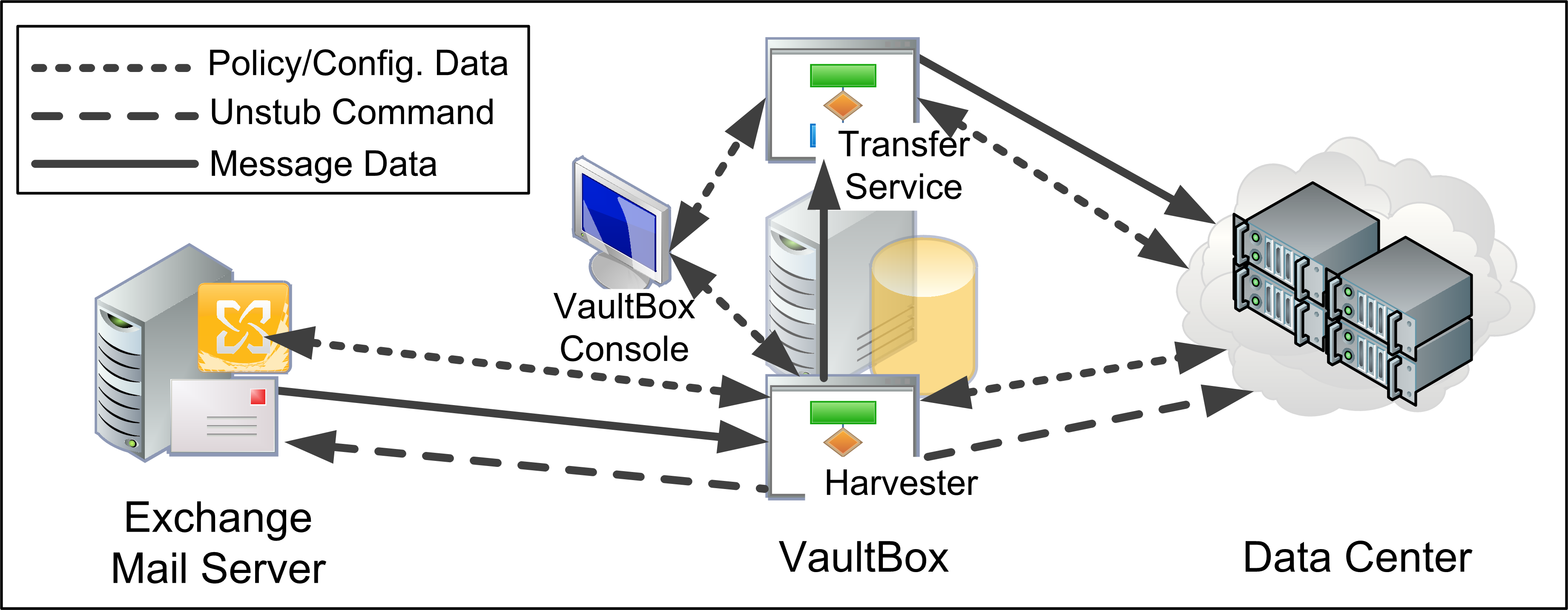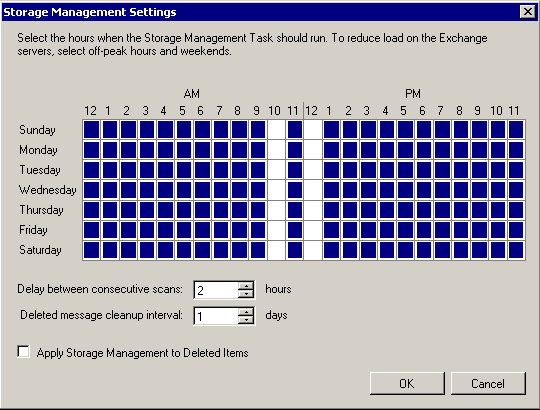Configuring Scan and Data Transfer for Storage Management Policies
To use the storage management feature, you must have at least one VaultBox installed. The VaultBox is responsible for coordinating the transfer of data from your organization’s Exchange servers to the data center.
The VaultBox Harvester component communicates with the data center to determine storage management policy criteria. The Harvester scans the Exchange server looking for messages subject to storage management policies. The Harvester gathers the messages to be stubbed, and when the attachment data has been collected, it is placed in a queue for transfer to the data center through the Transfer Service component. This data transfer continues until the queue is drained, regardless of the settings on this screen.

Data Transfer for Storage Management
Use the VaultBox Console to configure Exchange scanning and Transfer Service parameters. To launch the VaultBox Console, from the Windows Start menu select Start > Programs > Aurea > VaultBox Console on the machine on which it is installed.
The Transfer Service Status fields display following parameters:
- Queue — The number of messages to be transferred to the data center
- Rate — The transfer speed, in messages/second and KB/second
- Free Space — The amount of space remaining on the VaultBox
Changing the data transfer settings for Storage Management:
- In VaultBox section, click Configuration.
- Click the VaultBox tab to display data transfer settings.
- The Outbound Bandwidth section controls data transfer between the Transfer Service and the data center. In the Number of connections field, use the up/down arrows to alter the number of connections (threads) used by the process.
- In the Bandwidth Utilization limit field, change the amount of bandwidth used for data transfer. (A setting of 0 in this field allows unlimited usage).
- The Free Space Margin section prevents the storage management task from using excessive disk space. In the Minimum available space field, set the space threshold below which the storage management task should suspend activity.
- Click OK.
Configuring Storage Management parameters
- Open the VaultBox Console.
- Under Storage Management Task, if Storage Management processing is not running, Start will be shown and you can continue on to the next step. If Storage Management processing is running, then Stop is shown. Click Stop to halt Storage Management Task processing.
- Click Edit Settings.

Storage Management Settings
- On the graph, click squares in the day/time grid to indicate when the Harvester can scan Exchange for eligible messages. A blue square indicates scanning can take place during the hour; a white square indicates scanning is prohibited during that hour. You can click individual squares to change their status, or click days or hours to turn processing on or off for that entire day (row) or hour (column).
NOTE
To limit the load on the Exchange server, schedule scanning during periods of low user activity such as after business hours and on weekends.
- In the Delay between consecutive scans field, set the amount of time to wait between scans during a scheduled scanning period. The amount of time it takes to complete a scan of Exchange varies according to the amount of data to be analyzed and transferred. If the amount of scheduled time expires before a scan completes, the Harvester finds an appropriate stopping point and resumes scanning from that point during the next scheduled period. If scanning completes within the scheduled period, the Harvester waits for the amount of time configured in the Delay between consecutive scans field before starting another scanning cycle.
- In the Deleted message cleanup interval field, set the frequency at which the Harvester examines Exchange for deleted messages containing stubs. Periodically, the Harvester must resynchronize with the Exchange server to make sure that changes are reflected in the data center. For example, an attachment may have been stubbed and stored in the data center according to a storage management policy. If the end user later deletes the message, the data center needs to be updated to reflect that the attachment no longer must be stored. This periodic synchronization is controlled by the Deleted message cleanup interval.
- Storage Management does not typically collect messages that users have deleted. However, if you want Storage Management to consider messages in users’ Deleted Items folders eligible for storage, click the Apply Storage Management to Deleted Items check box.
- Click OK to save the new settings.
- Click Start to restart the Storage Management Task with the new settings.